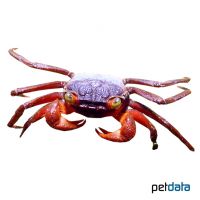Mandarin Crab (Geosesarma notophorum)
| Mandarin Crab Geosesarma notophorum | |
|---|---|
| Name | Mandarin Crab |
| Name Lat. | Geosesarma notophorum |
| Family | Sesarmid Marsh Crabs |
| Family lat. | Sesarmidae |
| Order | Decapods |
| Order lat. | Decapoda |
| Origin | Sulawesi |
| Habitat | Wetlands |
| Diet | Crab food, insects, leaves, fruits |
| Humidity | 70-90 % |
| Behavior | Peaceful |
| Keeping | Pair, group |
| Care Level | Easy |
| Housing | Humid terrarium |
| Breeding | Difficult |
| Life Span | 2-3 years |
| Protection | No |
| Metric Units | |
| Size | 2-3 cm |
| Temperature Day | 24-28 °C |
| Temperature Night | 20-22 °C |
| Housing Size | 40 x 30 x 30 cm |
| US Units | |
| Size | 1" |
| Temperature Day | 75-82 °F |
| Temperature Night | 68-72 °F |
| Housing Size | 15" x 15" x 15" |
Distribution and habitat
The natural range of mandarin crabs is on the island of Sulawesi (Indonesia). They live mainly terrestrially, often also on trees near bodies of water, such as ponds, ponds, streams and floodplains.
Maintenance
They need a terrarium (aquaterrarium) with a deep substrate suitable for cave building, made of non-rotting substrate such as sand-peat mixture with coconut fibers and sphagnum moss with a drainage, covered with leaves and pieces of bark
In addition, climbing branches with rough bark and branch forks in which water can collect. Artificial plants are advantageous as privacy screens, which can be easily removed for cleaning
They need a shallow water basin for drinking and bathing that is not too deep (danger of drowning). Regular water changes are required to maintain water quality
Daily 1-2 times the inside of the terrarium must be finely sprayed with water (humidity), but better is a rain or fog system.
| Temp. day: 24-28 °C | Temp. night: min. 20 °C | Humidity: 70-90 % |
The lighting duration must be 10-14 hours depending on the season. Very suitable are daylight fluorescent tubes with low UV content, supplemented with spotlights.
Diet
They need animal and vegetable food. The food supply consists of foliage (oak, beech, sea almond tree), vegetables (peas, carrots, zucchini, etc.), fruit (apple, pear, banana, etc.) and insects, supplemented with high-quality dry food for crabs and crayfish and commercially available frozen food mixtures. It is important to regularly add minerals (cuttlebone, calcium powder) and vitamins
Unaccepted food should be removed after 4-5 hours. A regular and varied diet promotes health and prevents deficiency symptoms
Behaviour and compatibility
They are well tolerated social animals and should be kept in a harem, one male with several females, or at least in pairs. Socialization with other mangrove crabs is not recommended.
Basically, only mutually compatible species with similar requirements should be socialized
Reproduction and breeding
Males have a narrower abdomen and larger claws, females are usually more strongly colored
Crabs have abbreviated larval development in the egg and release fully developed juveniles (not larvae). Pregnant females, which carry about 20 eggs (about 1 mm in size) in their abdominal pouches, reside primarily in burrows and burrows they dig themselves. The young require a pool of water for their development.
Important
With increasing age, the animals live predominantly terrestrial
Special care should be taken to cover the terrarium well, as they are escape specialists. Escaped crabs dry out quickly.
The terrarium must have good ventilation without drafts and meet the species specific needs. Measuring devices such as thermometers, hygrometers, etc. are necessary. The lighting must correspond to the species-specific day-night rhythm and must be installed in such a way that the animals cannot injure themselves. Contamination must be removed regularly.
Further literature can be found in your pet store.
References
Text: petdata; Image: petdata
Source: WERNER (2002): Garnelen, Krebse und Krabben im Süßwasseraquarium, Verlag ACS; ENGELMANN & LANGE (2011): Zootierhaltung - Tiere in menschlicher Obhut: Wirbellose, Verlag Harri Deutsch
